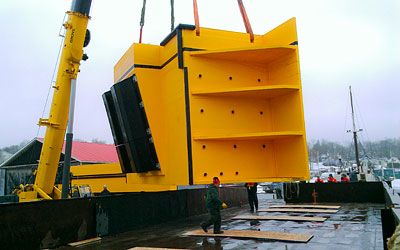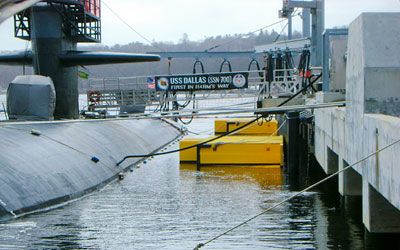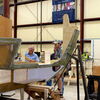Composite innovations land Kenway $4M Navy deal
Defense contracting has been a strength of Maine companies for decades, from Bath Iron Works and Saco Operations, formerly Saco Defense, on down. Kenway Corp. of Augusta is now poised to join the fold, and is midway through a Navy contract totaling $4 million that could lead to significant growth for the 65-year-old family-owned company.
The composites manufacturing firm, which currently employs 70, was tapped to provide “camels” — the barriers placed between ship and pier — for Navy submarines. The initial contract calls for four sets, the last of which will be delivered in November to a New London, Conn., submarine base.
These are not your ordinary boat bumpers. The high-tech, 100,000-pound camels use a composite design that replaces the steel-frame units previously employed by the Navy, according to Kenway President Ian Kopp. He says that about a dozen current employees are dedicated to the camel project, most of them hired specifically for that purpose.
“We had to do some significant R&D before we were ready,” Kopp says. Specifically, the firm’s intrusion molding process, which relies on creating vacuums to fill the molds, required fine-tuning to deal with the enormous size of the camel components — doing things on “a much grander scale” than before, he says.
The Navy began experimenting with composite prototypes as early as 2000 is an effort to provide a more cost-efficient mooring system for its submarines, which are deployed around the world in more than 30 ports. The steel-framed camels were subject to corrosion and marine deposits, and required expensive maintenance every two to five years. The composite prototype required “virtually no maintenance” after 10 years in the water, Kopp says.
Kenway was the successful bidder for the first commercial contract in 2011, just a month after chief engineer Jake Marquis joined the Kenway staff from the University of Maine’s Advanced Structures and Composites Center. Although Kopp says it wasn’t envisioned that way originally, Marquis has spent much of his time redesigning, manufacturing and then producing the camel modules.
Part of the technical challenge lies in figuring out how to dampen the immense forces involved when a 17,000-ton submarine approaches the pier.
“It has to be designed for impact at a half foot per second. The momentum is still considerable,” Marquis says.
Kenway won the contract over its primary competitor, a similarly sized company, Composite Advantage of Dayton, Ohio, which had built an earlier set of camels at New London in 2010.
“They offer a very high quality product, and are exactly the kind of competitor you want to have,” Kopp says.
He says that Kenway and Composite Advantage “are probably the only qualified bidders” for the job the Navy needed carried out.
One advantage for Kenway was its location. It was able to truck the six finished components to a pier in Belfast, where they were assembled by Kenway employees and then floated by barge to New London. That way, “they’re able to avoid tying up the submarine piers for two or three weeks at a time,” Kopp says.
Kenway has previously produced various components for the Department of Defense, including coverings for the exposed parts of submarines built and refitted at the Portsmouth Naval Shipyard and components for the DDG-1000, or Zumwalt-class, destroyers built at BIW. But the camel contract is its largest to date.
Now that Kenway has won the first round, Kopp is optimistic that it will be able to continue supplying the Navy. The next contract could come as early as November, depending on when the Navy opens the next round of bidding, and Kenway is in the running to supply the Norfolk, Va., sub base as well as others worldwide.
“Ideally, we’d make a seamless transition into a new contract, so we can keep everyone busy who’s now working on the camels,” Kopp says.
Cutbacks through the federal sequester are a concern, he acknowledged, but have not affected the Navy’s production timetable yet.
“These are components they need to operate the fleet safely, and that need is going to be there for a long time,” he says.
Read more
Composite manufacturer Kenway Corp. acquires assets of Harbor Technologies











Comments